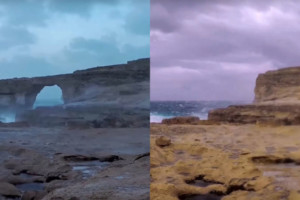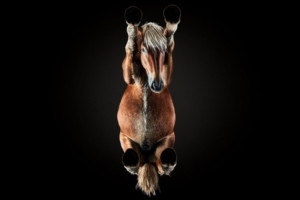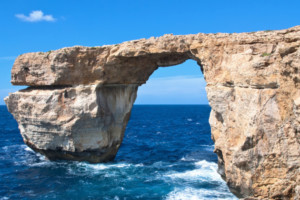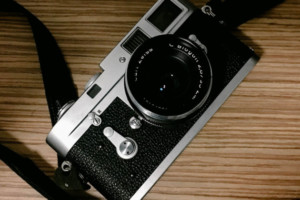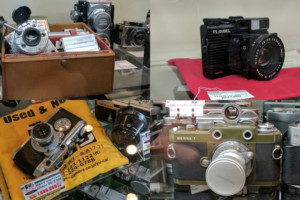
The inevitable just happened: nature has taken away what it created a long time ago. All parts of the world famous Azure Window in Malta are now gone — even its base was swept away by the sea.
In September 1933, LIFE magazine photographer Alfred Eisenstaedt traveled to Geneva to document a meeting of the League of Nations. One of the political figures at the gathering was Nazi propaganda minister Joseph Goebbels, one of Hitlers most devout underlings and a man who became known for his “homicidal anti-Semitism.”
Eisenstaedt was a German-born Jew. Not knowing this at first, Goebbels was initially friendly toward Eisenstaedt, who was able to capture a number of photos showing the Nazi politician in a good and cheerful mood (as in the photograph above).
Photographer Aydın Büyüktaş has published a new series of photos as part of his delightful Flatland series, which shows landscapes folding upon themselves like something out of the movie Inception.
Everyone knows what a horse looks like, but have you ever looked up at a horse from below? Photographer Andrius Burba wants to show you what this unusual perspective looks like through his latest project, titled Under-Horse.
One of the best known photography locations in the world has disappeared. Malta’s famed Azure Window limestone arch on the island of Gozo collapsed into the sea yesterday, leaving a conspicuously, tragically empty space in its wake.
We’re all familiar with the fuzzy circles that bokeh creates usually behind our main subject, but this lesson is about creating bokeh in front of the subject. And that is what Mark Wallace is about to show us in the 6-minute video above. This episode of Adorama TV is about getting a kind of outdoor feel and adding depth to your indoor portraits.
How do you go about shooting a wedding when the ceremony is half underwater? That’s what the photographers at Del Sol Photography were challenged with recently when they worked a wedding out in the middle of the ocean.
Who said that hi-end lighting equipment has to be expensive? And who says the only way to shoot with fluorescent light is to use the flicker-free Kino Flo lights that can cost you thousands of dollars?
I began using my fluorescent lighting technique nearly 10 years ago, long before Kino Flo’s and Peter Hurley became popular. I have been asked to describe it so many times that I decided it was time to put together a few tutorials to show how to build it and how to use it. In this article, I am going to deal with “how-to use” the fluorescent studio lights.
Anything can happen when cameras are rolling for live TV, and sometimes hilarity ensues. For a daily dose of humor, check out this video that shows what just happened today during a live broadcast of BBC News.
Being in the photography business successfully for 40 years has been an amazing journey and a great accomplishment for me. I believe that the people I meet are the best clients anyone could wish for.
In November 2016, I was in a transitional part of my life (I still am) and was considering selling my Leica M2 and switching to a digital Ricoh GR. I listed the camera on several Facebook camera trading groups and the Australian/UK Craigslist alternative, Gumtree. Long story short, I was scammed while trying to sell it.
This year marks the point at which I have been using Hasselblad cameras for over a decade. My first was a 201F in 2007, before moving to a 203FE in 2011 and adding a 202FA in 2015.
When I first started photography, I struggled a lot with lighting. In the beginning, we’re often told to shoot our subjects in open shade, but if you don’t know how to do this properly the results can be disastrous: faces with dark shadows, eyes with no depth, overexposed backgrounds, etc.
Popular Photography, the largest circulated imaging magazine that launched its first issue in May 1937 in New York City, has ceased publication after being continuously in production for 80 years. The March/April 2017 issue will be the last in print.
Independent French bookstore Librairie Mollat is going viral, but not because of anything particularly literary. No, this publicity boost is because they’ve gotten really creative with their Instagram account.
YouTuber Chris Chris captured the above video showing what happens when your camera’s frame rate is perfectly synced to the rotation speed of a helicopter’s rotor: the blades are frozen at the same angles in each frame, making it look like the helicopter is magically floating around with frozen rotor blades.
Japanese camera manufacturers dominate the digital photography landscape, so it might come as a surprise that the used film camera market is also thriving in Tokyo.
Marcus DeSieno’s Surveillance Landscapes are unlike any other landscape photography series you’ve probably ever seen. While most landscape shooters trek into the wilds, camera and tripod at the ready, DeSieno captured all of these images from the comfort of his own home… by hacking into security cameras.
It doesn’t matter if you’re a beginner, intermediate, or even a professional, you’ll want to give Broncolor’s free “How To” page a look. There, you’ll find nearly 100 pro lighting examples—beautiful photos, each accompanied by a gear list, description, and lighting diagram. It’s a tutorial gold mine.
Canon made an unusual move in 2017 by announcing the Canon 77D as the first camera in a new line that fits between the 80D and the 800D (AKA the Rebel T7i). If you’re scratching your head about what makes the 77D different, check out the 4.5-minute video above by ZY Productions about 8 differences between the 77D and 80D.


